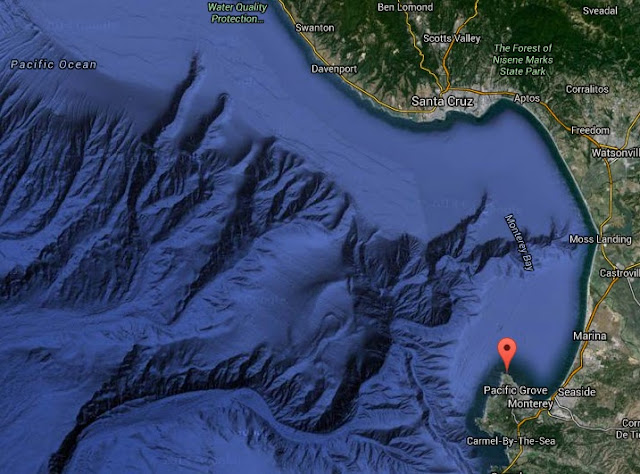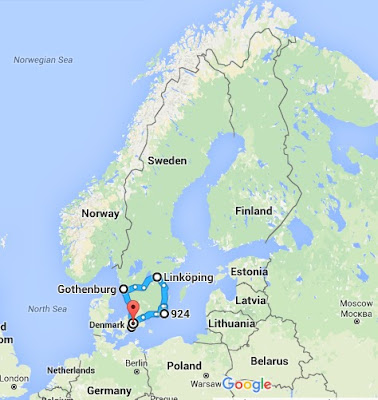This weekend I made my annual fall pilgrimage to Monterey, California for several days of sea birding with pelagic guru and close personal friend Debi Shearwater of Shearwater Journeys. Last year, during my petroleum-free bicycle Big Year, I wasn't able to do any pelagic birding beyond that which I could do from shore. I was certainly excited to get back onto the water this year!
Out on the wate-r-r-r-r-r-r-r-r!
Monterey Bay is the premier sea birding destination in North America, and, with 3 trips scheduled on 3 consecutive days, I hoped to tap into both the resident and potentially rare seabirds the bay has to offer. For those that have not visited the region before, I offer the following map. What you see here is the huge submarine canyon that lies beneath the surface of Monterey Bay. In a matter of a few miles, the sea floor drops from 100 to 1000 fathoms. Recall a fathom is 6 feet. That means the ocean is well over a mile deep at some points. That's deeper than the Grand Canyon! Nutrient upwellings along these step, underwater canyon walls attract little fish, bigger fish, and, in turn, marine mammals and pelagic birds. It was here that we headed on each of my trips this past weekend.
Monterey Seavalley
One thing that I think people generally fail to realize it exactly how dynamic the ocean is. My three trips, again on 3 consecutive days, were completely different though we generally visited the same general areas on each day, the section of the canyon directly northwest of the pin I have placed at Point Pinos. As is often the case with pelagic birding, we were at the mercy of the wind on each day. The first day was very blustery, blowing at 15-20 knots (A knot is a nautical mile per hour. A nautical mile is 1.15 standard miles). As a result we did not spend as much time as we had hoped in the deeper water. We did manage Sooty, Black-vented, and Pink-footed Shearwaters, all 3 Jaegers, Northern Fulmar, Black-footed Albatross, Black and Ashy Storm-petrels, and Red and Red-necked Phalaropes. The highlight of the day was the Humpback whale show in the inner bay (near Moss Landing). Upwards of 40 whales were feeding on huge schools of anchovies! It was very impressive! We also observed a Loggerhead Turtle, an apparently rare sight this far north the Pacific Coast. We also found a school of well over 1,000 Commn Dolphins. Photography on this day was virtually impossible, but I did manage a few shots before it got too bumpy.
Heermann's Gull - winter plumage adult
The wind on Saturday, my second trip, cooperated a bit more. As a result we were able to spend a bit more time in the deeper water. Species were fairly similar to the first day with the notable additions of Manx shearwater, Buller's shearwater, Flesh-footed Shearwater (seen only at a great distance), and Least Storm-petrel (missed by me, ugh!). The whale show was even more impressive than the previous day with 50+ giants feeding all around the boat. At one point a group of actively feeding whales surfaced 35 feet from the boat. I was too busy yakking with Debi and did not have my camera ready - @#$%^&!
Black-footed Albatross
Black-footed Albatross
Pacific Golden-plover, back on shore after trip 2
So easy this year and so difficult last!
Day 3 was the most interesting of the bunch. The wind and seas were calm, but we had fog on and off throughout the morning. We fought through some bird thin times early in the day to find some very large Storm-petrel rafts later in the afternoon. Formerly common in Monterey Bay, Storm-petrel flocks of any size have been virtually absent for the past 2-3 years, possibly due to the warmer than usual waters associated with the current El Niño. Amidst hundreds of Ashy Storm-petrels, we found dozens of Blacks and a few Wilson's. Most notably, we found a single, silvery Fork-tailed Storm-petrel and several Least Storm-Petrels in with the others. These last two represented life birds for me and were cause for great excitement! As I was focused on observing the fast moving little lifers, I did not even bother with photos; I wanted to make sure I got countable looks before they vanished!
Northern Fulmar
Northern Fulmar showing primary molt
The Storm-petrels represented ABA birds 696 and 697 for me. In related news, the Red-legged Honeycreeper I observed on Thanksgiving of last year was accepted (9-0) by the Texas Bird Records Committee! You can read more info on that here. If the ABA follows suit, I'll be able to add that bird at some point. The jury is still out on the potential ABA 1st Gray Thrasher I observed in San Diego a few months back. I assume I'll lose Hoary Redpoll as a lump with Common Redpoll at some point, but I'm knocking at 700 ABA species any way you cut it! Right now of my 697, 695 come from the lower 48 and 2 are from Canada. I have not yet birded Alaska. Maybe some day.....
Anyway, enough of the listing stuff for now. The whole weekend was fantastic. Sonia joined me on the 3rd of the 3 trips. She and Debi really hit it off. They had a good time giving me crap in between birds. For those that haven't met Debi, she's worth the price of admission on her own. If you ever make it to Monterey Bay, particularly in the fall, you should seriously consider taking a trip with her. It won't be dull, I promise!
Leaving the dock on Day 3






































